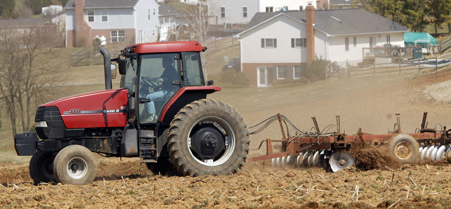Farm Service Agency welcomes proposed funds for IT upgrade
Money included in the House's economic stimulus package would help FSA reduce delays in processing payments for farmers, officials say.
 Funds in the economic stimulus bill to update networks at the Farm Service Agency would help farmers make better business decisions, supporters of the bill say. (
Bill Ryan/AP
)
Funds in the economic stimulus bill to update networks at the Farm Service Agency would help farmers make better business decisions, supporters of the bill say. (
Bill Ryan/AP
)
The $245 million the House set aside for maintenance and modernization of the Farm Service Agency's information technology systems in its version of the economic stimulus bill is long overdue, agency officials said on Thursday.
"The technologies we're running are built on 1980s vintage technology," said Dennis Taitano, chief financial officer and acting associate administrator for operations and management at FSA. "That's the problem we're having."
The funds -- only a small chunk of the $45 billion in IT spending outlined in the House stimulus bill -- will not cover the full cost of upgrading the agency's systems, but will go a long way toward doing so, Taitano said.
The Farm Service Agency administers myriad programs, including initiatives to help farmers determine what to plant, subsidies to grow (or not grow) specific crops and loans to help with upfront costs. The agency operates more than 2,300 county offices that certify farmers for programs and pay-out subsidies.
The agency's computer network has been unable to keep up with its payment processing needs. In January 2007, FSA experienced network outages, resulting in a 30-day period when payments were sent out late or not at all.
"FSA is helping farmers by advising them on what the current commodity prices are, helping with crop insurance, loan and subsidy programs," said Ray Bjorklund, chief knowledge officer and senior vice president of the McLean, Va., market analysis firm FedSources. "There is so much timing sensitivity and complexity...[farmers] need information to the nearest day so they can make a good business decision about whether to sell your product or farm a commodity for the next year."
Taitano said funding constraints have prevented FSA from upgrading its IT infrastructure. He noted that Rep. Collin Peterson, D-Minn., chairman of the House Agriculture Committee, has been a strong advocate for IT modernization funding.
The Senate still is piecing together its version of the stimulus package.
According to FSA Chief Information Officer Jim Guinn, the agency relies on dated IBM mainframe servers that use the COBOL programming language. Peterson recently said it was time for the agency to abandon COBOL .
"The problem is well-recognized and [is] getting the proper level of attention," Guinn said. "We are running the oldest technology in the U.S. Department of Agriculture."
The outdated green screen technology at FSA makes it difficult to leverage innovations such as remote sensing and satellite imaging, which can be used to track what crops are being grown and where, according to Bjorklund.
Guinn is aiming to streamline FSA's architecture to allow it to build on newer, faster and more secure technologies. Applications for farm loans and subsidies involve numerous forms, which are processed as paper and then manually added to the electronic system.
"Everything is so form-driven and paper heavy out in our county offices," Taitano said. "The vision is that we would provide a self-service [Web] portal so a farmer doesn't have to come into the county office."
Patrick Hanley, project manager for the program to modernize the farm benefits system, said the agency is working closely with the Office of Management and Budget to make sure the new systems would comply with the federal enterprise architecture, to ensure FSA's systems can share information with other federal agencies. Hanley said the $245 million in the House stimulus bill would allow FSA to stabilize the current infrastructure and initiate modernization efforts. The money would satisfy estimates for the first two years of implementation, Taitano said.
Agency officials also are looking into commercial off-the-shelf software solutions that could help with payment processing, according to Hanley. But the initial focus will be on infrastructure and making sure the back-end servers and network are capable of handling the volume of transactions at FSA, he said.
He added that improving customer service for farmers and ranchers will remain a "major goal."
NEXT STORY: Work in Progress: Upcoming FCW Features





